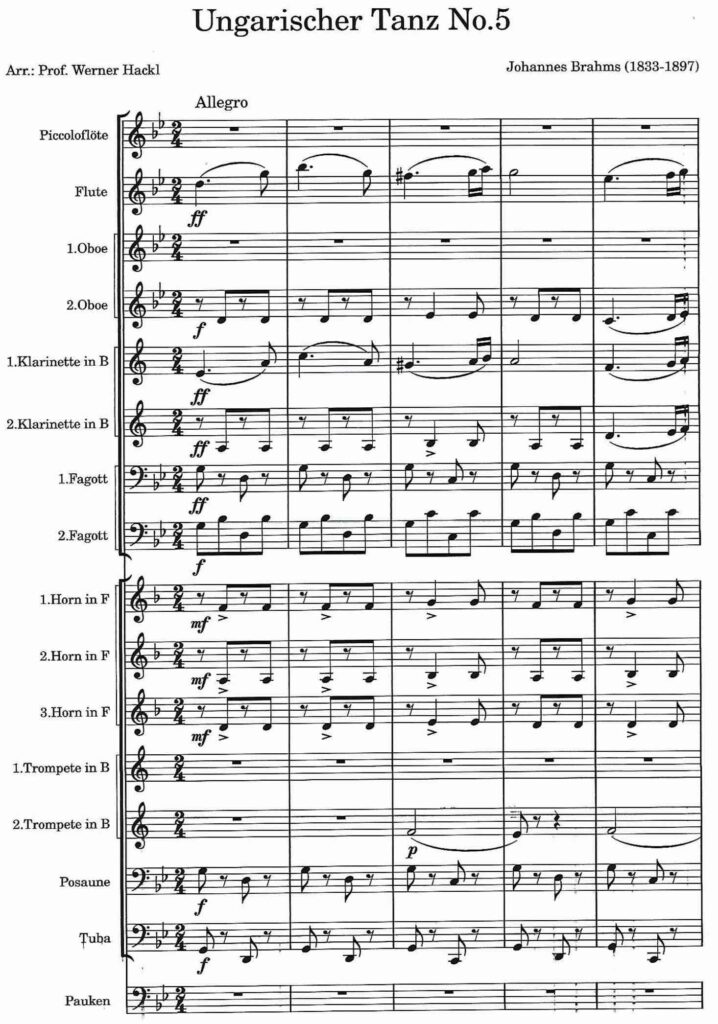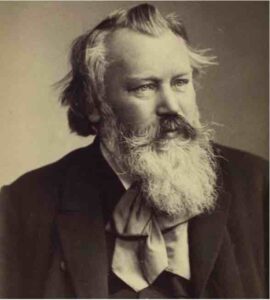Brahms Johannes (1833-1897) Ungarischer Tanz No.5

Johannes Brahms, geboren in Hamburg, gestorben in Wien war Komponist, Pianist und Dirigent. Seine Kompositionen werden vorwiegend der Hochromantik zugeordnet; durch die Einbeziehung klassischer Formen gehen sie aber über diese hinaus. Brahms zählt zu den bedeutendsten Komponisten des 19. Jahrhunderts.
Die Ungarischen Tänze Nr. 1–21 (WoO 1) von Johannes Brahms sind ursprünglich Werke für Klavier zu vier Händen. Sie entstanden in den Jahren 1858–69
Beim Ungarischen Tanz No. 5 handelt es sich nicht um originale Gedanken Brahms’, sondern um Bearbeitungen vorgefundener Melodien. Allerdings sind die Vorlagen auch keine originalen Volkslieder ungarischer Roma. Das Hauptthema (32 Takte), das Johannes Brahms im Ungarischen Tanz Nr. 5 verwendet hat, schrieb der ungarische Komponist Béla Kéler in seinem Werk Erinnerung an Bartfeld op. 31. Beim Tanz No. 5 wurde die Tonart von fis-Moll auf g-Moll transponiert. Die Ungarischen Tänze No. 5 und No. 6 und gehören zu seinen populärsten Werken von Johannes Brahms. Prof. Hackl bearbeitete beide Tänze sowohl für Bläser-Orchester als auch für Bläserquintett.

Johannes Brahms, born in Hamburg, died in Vienna, was a composer, pianist and conductor. His compositions are primarily assigned to the High Romantic period; However, by incorporating classical forms, they go beyond them. Brahms is one of the most important composers of the 19th century.
The Hungarian Dances No. 1–21 (WoO 1) by Johannes Brahms are originally works for piano four hands. They were created in the years 1858–69
At the Hungarian Dance No. 5 is not about Brahms’ original thoughts, but about adaptations of found melodies. However, the originals are not original folk songs from Hungarian Roma. The main theme (32 bars) that Johannes Brahms used in the Hungarian Dance No. 5 was written by the Hungarian composer Béla Kéler in his work Remembering Bartfeld op. 31. In the Dance No. 5 the key was transposed from F sharp minor to G minor. The Hungarian Dances No. 5 and No. 6 and are among his most popular works by Johannes Brahms. Prof. Hackl arranged both dances for both wind orchestra and wind quintet.
| sound sample / Tonbeispiel | score/parts PDF download: € 38,- | add to cart / in den Warenkorb |
